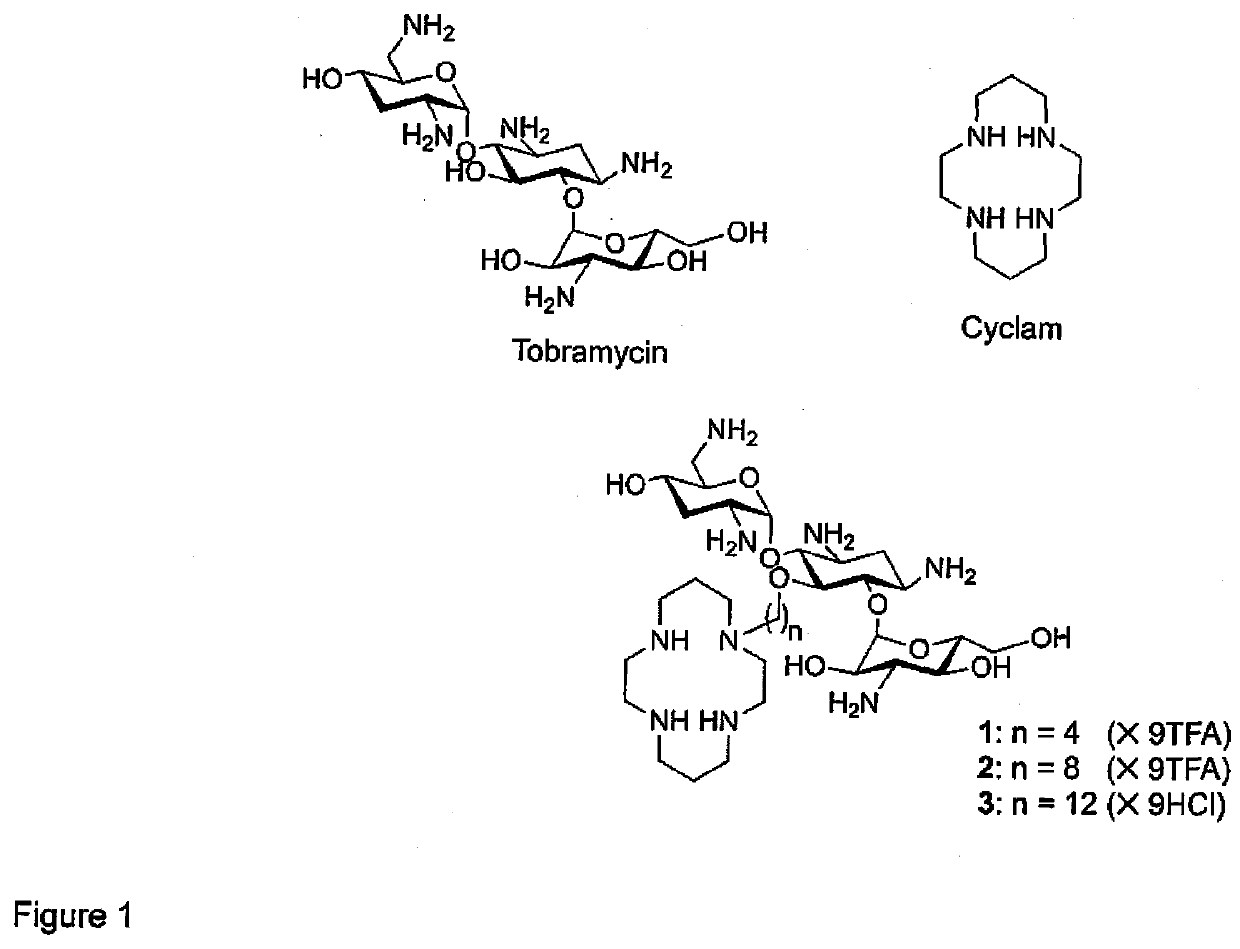Potentiation of B-Lactam Antibiotics and B-Lactam/B-Lactamase Inhibitor Combinations Against Multidrug and Extensively Drug-Resistant Pseudomonas Aeruginosa Using Non-Ribosomal Tobramycin-Cyclam Conjugates
a technology of b-lactamase inhibitor and b-lactamase, which is applied in the field of potentiation of b-lactamase inhibitor combinations against multidrug and extensively drug-resistant pseudomonas aeruginosa, can solve the problems of disrupting the om, carbapenem-resistant gram-negative bacteria is considered a public health crisis and a major global threat, and achieves the effect of increasing the fluidity of the outer membran
- Summary
- Abstract
- Description
- Claims
- Application Information
AI Technical Summary
Benefits of technology
Problems solved by technology
Method used
Image
Examples
example 1
d Synthesis
[0058]The design of tobramycin-cyclam conjugates (FIG. 1) was established from previous structure-activity relationships. Amphiphilic tobramycins with lipophilic groups at the C-5 position have been shown to lose ribosomal activities but retain the ability to permeabilize the OM of P. aeruginosa (13, 20). A lipophilic cationic neamine grafted to a cyclam moiety, a chelating agent, has also been reported to permeabilize the OM of E. aerogenes (34). Thus, tobramycin and cyclam were conjoined to each other at the C-5 position of tobramycin, using aliphatic hydrocarbon of different tether lengths, i.e. C-4, C-8, and C-12. The use of aliphatic hydrocarbon linker was to preserve the amphiphilic nature of amphiphilic tobramycins, while the various tether length was meant to investigate the optimal spatial separation between the two domains. Ligation of the resulting amphiphilic tobramycin to a cyclam domain was achieved via reductive amination in order to preserve the cationic n...
example 2
Synthesis of Tobramycin-Cyclam Conjugates 1-3
[0059]The amphiphilic tobramycin domain was prepared following previously reported protocol (35). Tobramycin 11 was purchased from a commercial source and the amino groups were first protected using di-tert-butyl dicarbonate (Boc anhydride), followed by silylation of the N-Boc-tobramycin intermediate with excess TBDMSCl to afford a partially protected derivative 12 with free OH at the C-5 position of the cyclitol ring. Alkylation of 12 in toluene with 1,n-dibromoalkane (n=4, 8, 12) in the presence of a phase-transfer catalyst (TBAHS) afforded bromoalkylated TBDMS-Boc-protected tobramycin intermediates. The terminal bromo-groups of these intermediates were then hydrolysed to afford compounds 14a-c and subsequently oxidized to their corresponding aldehydes 15a-c using PCC. Compounds 16a-c were prepared via reductive amination of aldehydes 15a-c with (Boc)3-protected cyclam 10, followed by stepwise deblocking—first by removing TBDMS groups u...
example 3
bial Susceptibility Screening
[0060]The antimicrobial activities of compounds 1-3 were assessed against a panel of Gram-positive and Gram-negative bacteria, and compared to the parent molecule, tobramycin, as shown in table 1. Whereas tobramycin by itself exhibited low MIC values (≤2 μg / ml) against susceptible strains, indicating potency, the MICs of conjugates 1-3 (≥16 μg / ml) were significantly greater than tobramycin against all strains, indicating a significant loss of activity. Compounds 1-3 were also inactive against Gram-positive bacteria which do not have an OM permeability barrier. This result is consistent with our hypothesis that a C-5 conjugation will abolish the ribosomal effects of tobramycin. The antipseudomonal activities of compounds 1-3 and tobramycin were further evaluated against a panel of MDR / XDR P. aeruginosa clinical isolates obtained from CANWARD (36, 37) and intensive care units (38) of different Canadian hospitals. These clinical isolates were either interme...
PUM
| Property | Measurement | Unit |
|---|---|---|
| Density | aaaaa | aaaaa |
| Density | aaaaa | aaaaa |
| Density | aaaaa | aaaaa |
Abstract
Description
Claims
Application Information
 Login to View More
Login to View More - R&D
- Intellectual Property
- Life Sciences
- Materials
- Tech Scout
- Unparalleled Data Quality
- Higher Quality Content
- 60% Fewer Hallucinations
Browse by: Latest US Patents, China's latest patents, Technical Efficacy Thesaurus, Application Domain, Technology Topic, Popular Technical Reports.
© 2025 PatSnap. All rights reserved.Legal|Privacy policy|Modern Slavery Act Transparency Statement|Sitemap|About US| Contact US: help@patsnap.com



